Tuk Tuk Tours
Explore Bangkok by the iconic tuk tuk
Aside from Bangkok, central Thailand misses out on much of the tourism brochure love that’s afforded to both the south and the north. Sometimes that’s understandable – this is largely rice cultivation country, and it’s not as tightly packed with winning tourist attractions as other parts of Thailand – but that’s not to say there aren’t still heaps of gems worth tracking down. Planning on spending some time in central Thailand? Here’s where we recommend you visit.
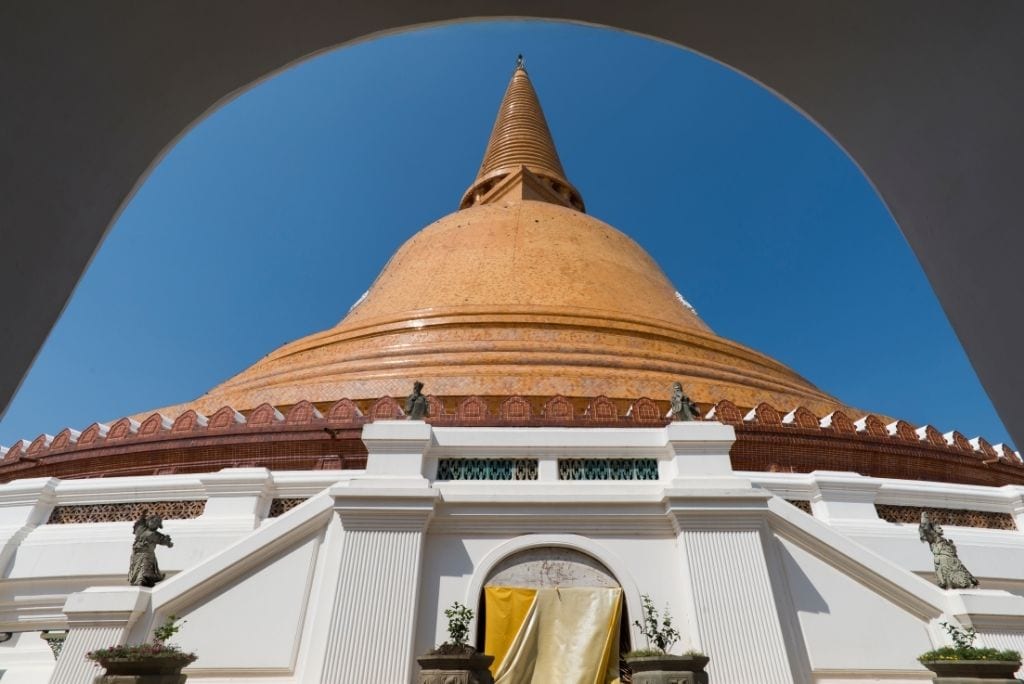
Just on the outskirts of the Thai capital, Nakhon Pathom is a generally under-visited destination, but it does hold its share of low-key attractions. Having said that, its star attraction – Phra Pathom Chedi – is nevertheless grandiose in size, holding the record as it does for the world’s tallest Buddhist stupa, and equally as one of the Buddhist sites in Southeast Asia that dates back the furthest.
Equally impressive is Phuttamonthon, among the tallest standing Buddha statues in the world. While you’re in Nakhon Pathom, you might also choose to visit local-feeling Lamphaya floating market – one of our favourite floating markets in the reachable vicinity of Bangkok – and the early-20th-century Sanam Chandra Palace and the park of the same name.
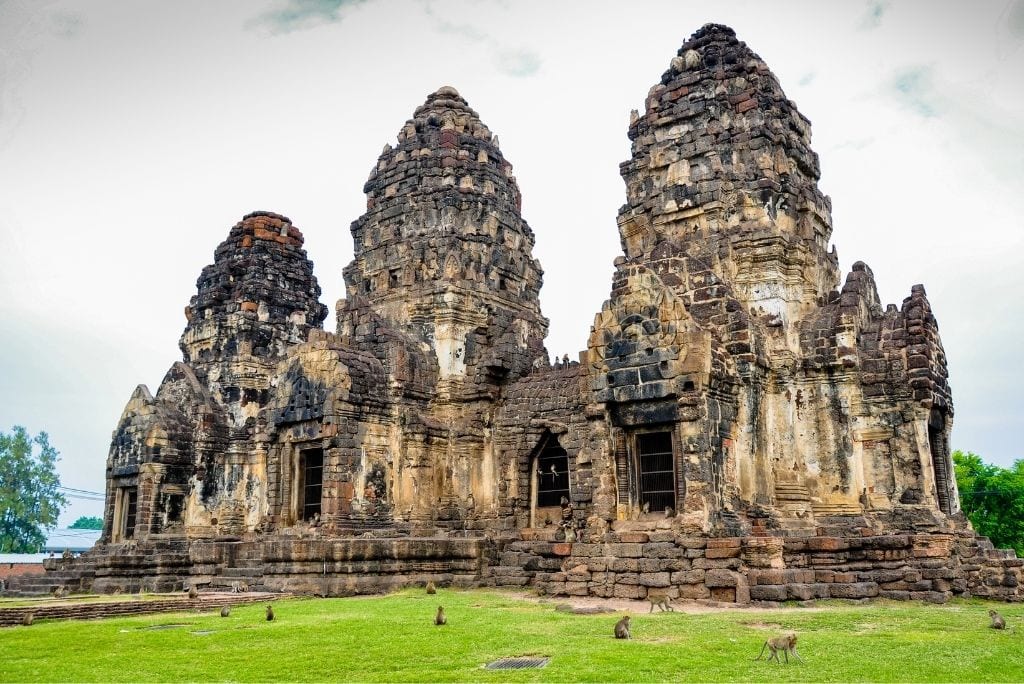
Lopburi is as famous for its monkeys as it is anything else. Easily reached by train or road from Bangkok, the city is home to Buddhist temples like Wat Phra Si Mahathat, but it’s at the shrine-like Phra Prang Sam Yot monument – built in the era of the Angkor empire, of which Lopburi was an important centre – that the famous monkeys are most well known to congregate.
They are fed and looked after by the city’s officials, such is their value in attracting tourists, but you’ll want to keep a close eye on your belongings at all times (keep your bag closed, food and drink out of sight, and your camera and other possessions on a close leash), since it’s no overstatement to say that the creatures get everywhere in this town – hanging from stupas, scuttling across telephone cables, and generally getting in the way and making a nuisance of themselves.
There’s even an annual festival in their honour, in which they are fed a huge fit-for-humans buffet spread as a way to thank them for their services to Lopburi’s tourism scene.
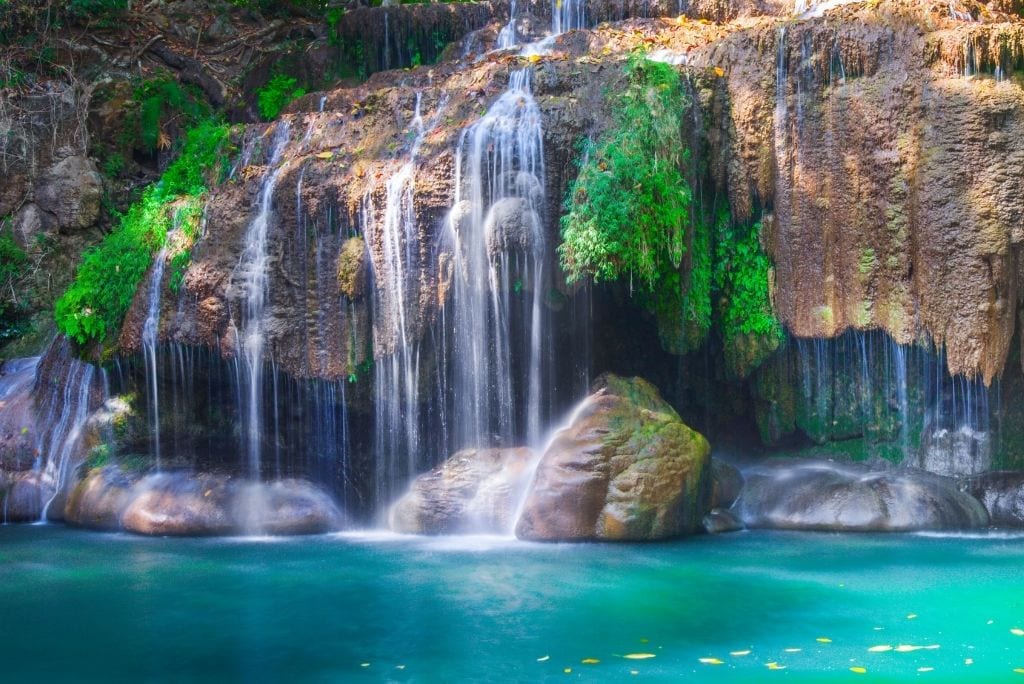
Just a couple of hours from Bangkok by road, or a train journey from the capital’s Thonburi station that later becomes the scenic route to the Death Railway’s terminus at Nam Tok, Kanchanaburi is one of central Thailand’s more popular spots. The provincial capital is famed for its mix of World War Two cemeteries and other memorial sites, natural attractions, and a popular and relatively hedonistic nightlife scene (for these parts, at least) that’s primarily set along Maenam Kwai Road, which itself leads to the infamous Bridge Over the River Kwai.
This is also one of the most affordable parts of Thailand in which to travel – no more so than at the likes of the 10 Baht Bar on Maenam Kwai Road, where just a single 10-baht coin will get you a shot of one of the bar’s cheapest whiskies (among them the amusingly named Black Cock) with a mixer. Other bars and restaurants line the strip, and Kanchanaburi is also a popular place to participate in a cooking class.
Elsewhere, highlights – many of them the stuff of Thailand’s tourist literature – include the seven-tiered Erawan waterfall within the national park of the same name, moving cemeteries containing the graves of WW2 soldiers, a ride on the picturesque Death Railway laid by prisoners of war, and Hellfire Pass, a harrowing outdoor museum at the site of the part of the railway that was most difficult to lay and caused the deaths of the POWs involved in its construction.
Those keen on getting off the beaten track also shouldn’t leave Kanchanaburi province without seeing the outpost border town of Sangkhlaburi (see below).
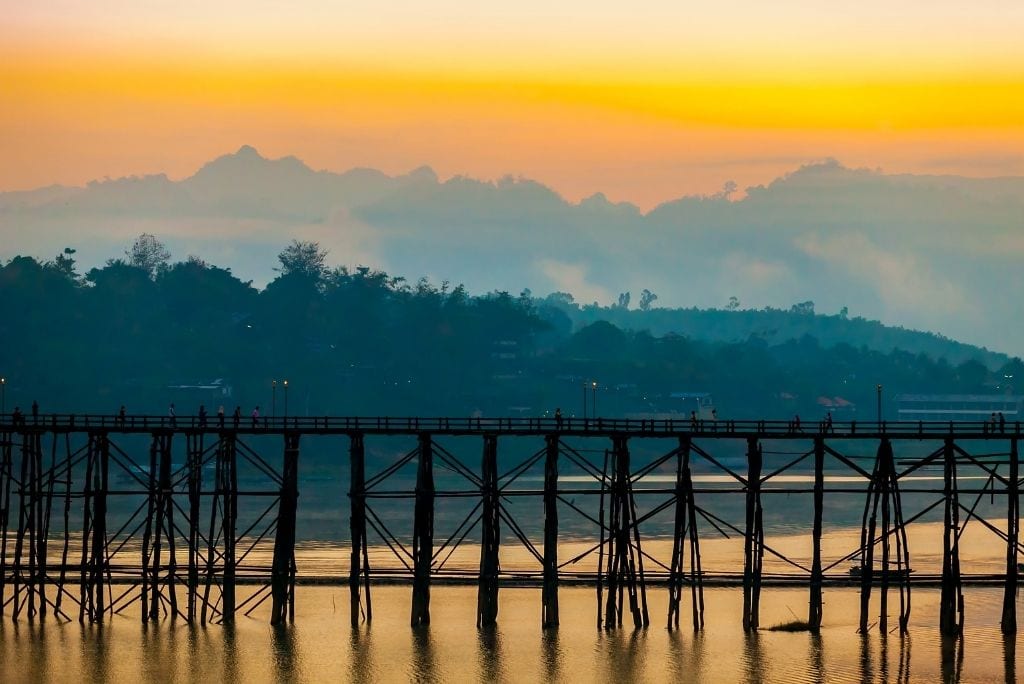
Little-known Sangkhlaburi – just a short distance from Thailand’s border with Myanmar, in the outer reaches of Kanchanaburi province – is our kind of place: quiet, low-key, and local-feeling, yet supremely beautiful and brimming with things to do and see. Take a walk across the famous wooden bridge (the longest handmade wooden bridge in the country), across the manmade Vajiralongkorn Lake and connecting modern-day Sangkhlaburi’s main town with the village of predominantly Mon settlers from neighbouring Myanmar.
Make the trip across the bridge in the early morning in order to catch the spectacular local fresh market on the Mon side, where you’ll find delicious produce and snacks that you’ll likely not spot anywhere else in Thailand. Visit the sparkling, geometric-patterned Wat Wang Wiwekaram temple, and take a kayak or longtail boat out to see the remains of old Sangkhlaburi town, which sits beneath the lake having been deliberately sunk to create a dam. When the tide is at its highest, only a small white stupa can be seen protruding from Wat Samprasob temple, but when the water is lower you can see more of the structures or even get out and have a wander around what’s left.
Back on terra firma, make time for coffee at one of the town’s many cute cafés, and to simply soak up the town’s laidback vibe, where at times you’re just about as likely to meet a chicken crossing the road as you are a fellow traveller.
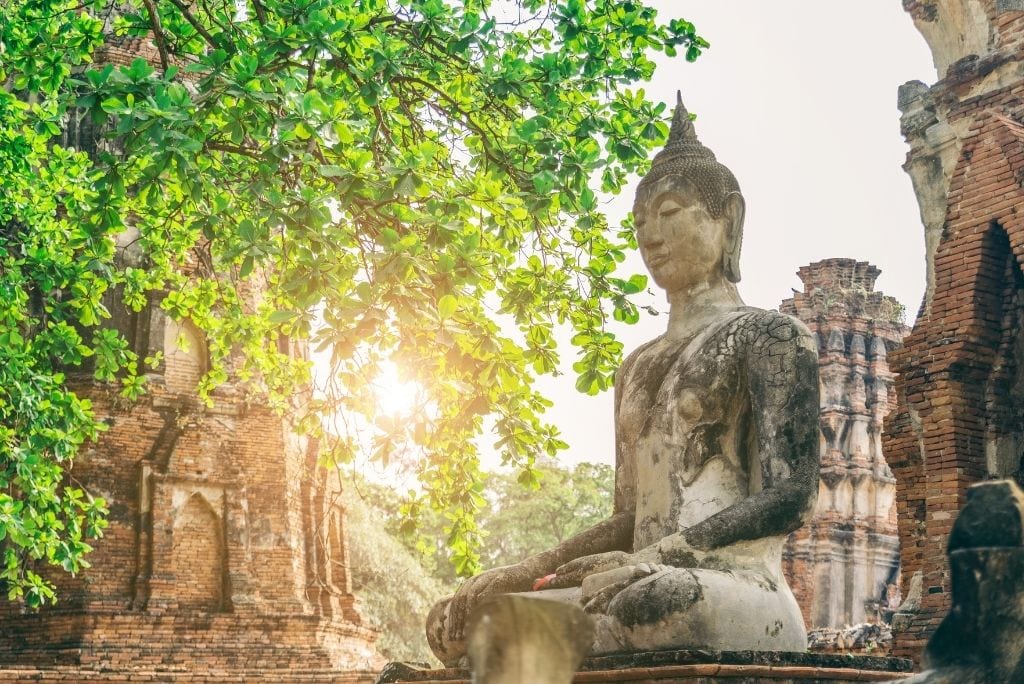
Close enough to Bangkok to make a visit in a day (and especially affordable if coming by train), Ayutthaya is famous for its temples – such as Wat Mahathat, where a Buddha head is photogenically and fascinatingly entwined in the roots of a banyan tree.
Ayutthaya makes for a great city to cycle around as you explore the various runs from the period when this was the capital of Thailand (then Siam) – other temples especially worth checking out include Wat Yai Chai Mongkon, Wat Phra Si Sanphet, and Wat Ratchaburana. Ayutthaya also has a particular reputation for its super-sized grilled river prawns, which are well worth seeking out.
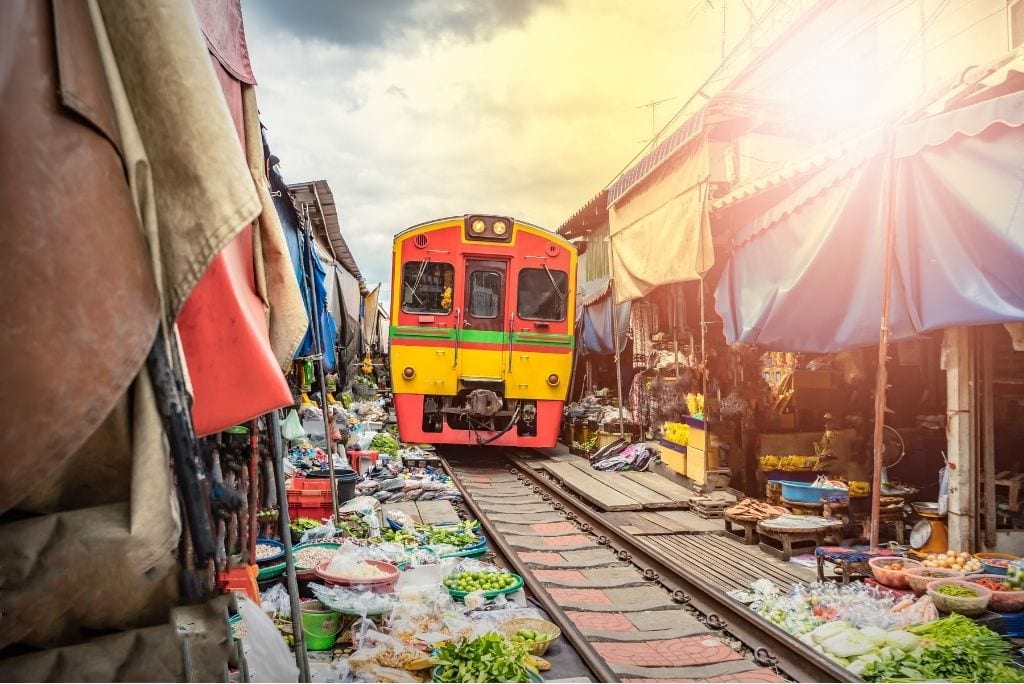
Thailand’s smallest province is perhaps most often visited by tourists headed to Amphawa floating market. While we’re big fans of Amphawa, it’s a shame that most get to see little else of the province, which variously goes by the names Mae Klong and Samut Songkhram – although the increasing level of publicity afforded to the city centre’s Talat Lom Hup ‘railway market’ (literally ‘umbrella market’, for the way vendors have to pull in their wares and their awnings every time a train from Mahachai passes right through the middle of the trading space) means that many floating market day tours also now make a stop here.
Indeed, coming by train from Bangkok’s Wongwian Yai station (changing trains at Mahachai, which also involves a ferry hop across the Tha Chin river) is our favourite way to get to and see Mae Klong. Once you’re here, other highlights worth making time for include Wat Bang Kung, a Wat-Mahathat-style sight (see above) where not just a Buddha image but an entire temple has been totally swallowed up in the roots and branches of a banyan tree.
Be sure to hunt down Tha Kha floating market, too – much lower-key than Amphawa, and infinitely more pleasant to visit than neighbouring Ratchaburi’s Damnoen Saduak (of which we’re not particularly fond), it’s one of the few truly authentic floating market experiences still around.
At Expique, we’re experts at showing you the unique parts of Bangkok and elsewhere in Thailand that most tours don’t take you to – and which you probably won’t discover on your own. Joining one of our tours or experiences (or having us create a custom tour for you) is a great way to make the most of your time in Thailand and ensure you leave with a memorable experience.
Are you visiting Thailand? Take a look at our expert recommendations for:
Where are your favourite destinations in central Thailand? Let us know in the comments!
Photos by redlegsfan21; Adam Baker; Eli Duke; Chris Wotton
Want to explore more of Thailand? Contact us about arranging to come on a custom-curated adventure with Expique.